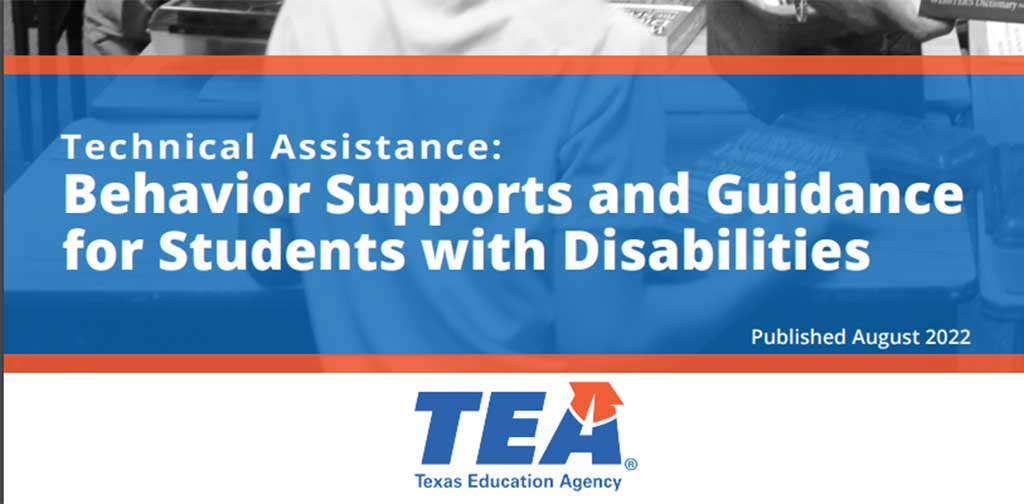If your child receives special education services under the Individuals with Disabilities Education Act (IDEA), did you know he or she may be eligible for a program of special education and/or services beyond the normal school year? Such services are commonly referred to as extended school year (ESY) services. Read on to learn how ESY might help your child, the types of services it might include, and how the Individualized Education Program (IEP) team would determine if your child is eligible.
ESY services are individualized special education and/or related services (such as speech/language therapy or occupational therapy) that are uniquely designed to provide a free appropriate public education (FAPE) to a student with disabilities (as mandated by IDEA). Need for ESY services is determined by the student’s IEP team (in Texas, this team is called the ARD committee). ESY services are provided beyond the normal school year of a school district — that includes both the days of the school year and the hours of the school day. ESY services must be provided at no cost to the parents. It’s important to understand that ESY services are not the same as:
- summer school
- compensatory services
- enrichment programs
ESY services are not limited to the summer break. While this is generally the longest break from the normal school year, ESY services may be needed during shorter breaks (such as winter and spring holiday breaks) of one or two weeks in length. ESY services can even be an extension of the student’s normal school day, such as a special tutoring program.
ESY services are not necessarily a continuation of the student’s entire special education program. Some students may need only certain instruction and/or related services (such as reading instruction or speech/language therapy) outside of the normal school year.
IDEA Regulations and Extended School Year Services
The IDEA regulations define “extended school year services” as special education and related services that:
Are provided to a child with a disability…
- Beyond the normal school year of the public agency (typically the school district);
- In accordance with a child’s IEP;
- At no cost to the parents of the child; and
- Meet the standards of the State Educational Agency.
For more information, check out the Texas Special Education Rules and Regulations document on the Legal Framework website at https://fw.esc18.net/display/Webforms/ESC18-FW-LandingPage.aspx
Who Is Eligible for ESY Services?
Any student who is eligible to receive special education and related services may be eligible for ESY. A student’s need — or eligibility — for ESY is determined by his IEP team, including the parent(s). The decision is based solely on the individual needs of the student.
While federal IDEA regulations provide little specific guidance about how to determine a student’s eligibility for ESY, they do offer a few general requirements. These are:
- All school districts must ensure that ESY services are available as necessary to provide FAPE to eligible students. This doesn’t mean that every school district must provide the services, but rather, each district must ensure availability. So, for example, a district might provide ESY services to eligible students by contracting with a nearby district or a private provider.
- The student’s specific type of disability does not determine eligibility. School districts are not allowed to limit ESY services to particular categories of disability. So, for example, a school district cannot have a policy that prohibits ESY services for all students with learning disabilities.
- School districts may not unilaterally limit the type, amount or duration of ESY services. So, for example, a school district may not have a policy that restricts ESY services to the same period of time that it conducts its regular summer school program for all students.
A school district may not use a lack of resources as a reason for not examining a student’s possible need for ESY services or for not providing ESY services to an eligible student.
How Is Eligibility for ESY Determined?
As noted earlier, the federal IDEA law and regulations provide little guidance on how to determine the need for ESY services. Therefore, the eligibility procedures and considerations have evolved from case law — the body of law created by judges’ written opinions in cases involving ESY services.
Determining a student’s need for ESY services must be part of the IEP process. Ideally, the IEP team should consider the need for ESY services at the initial IEP meeting for a student who is newly eligible for special education and at each IEP meeting thereafter — generally annually. This makes the consideration of ESY an integral part of any IEP meeting. However, if necessary, an IEP meeting can be called for the express purpose of considering the student’s need for ESY services.
For more information about ESY, visit the Texas Education Agency’s Extended School Year Services for Students with Disabilities webpage.
Criteria Used to Determine Eligibility
The most widely used criteria for determining the need for ESY services are regression and recoupment. This involves two findings:
- The IEP team must determine if the student is likely to lose critical skills during the time when services are not delivered — called regression.
- If the likelihood of regression is established, then the IEP team must determine whether the time the student will require to re-learn the skills lost — called recoupment — is excessive, particularly when compared to the time it takes a nondisabled student to regain skills lost during a school break.
Many students lose some skills over school breaks, and then must relearn those skills when back in school. This applies to short breaks like holidays as well as the traditional long summer break. The important distinction is whether the student with a disability will experience significantly more regression and will take significantly more time to recoup lost skills than the student without disabilities.
Determinations about regression and recoupment can be either retrospective (looking back at documentation of a student’s previous rates of regression and recoupment) or prospective (looking forward at the potential rate of regression and recoupment based on such information as expert judgments and observations regarding the student’s performance after very short breaks such as long weekends). It’s not necessary for a student to demonstrate previous regression in order to be eligible for ESY services. However, the determination should be based on objective data from a variety of sources.
Several states continue to use a regression and recoupment model for ESY eligibility. The U.S. Department of Education has clarified that states have the option of using recoupment and retention as their sole criterion in ESY eligibility decisions, but do not have to do so. Many states have established additional criteria based on cases in their respective circuit courts.
Along with regression and recoupment, the IEP team might consider:
- The nature and severity of the student’s disability. While the student’s type of disability alone does not determine whether or not there is a need for ESY services, the IEP team should examine whether the nature and severity of his disability are likely to significantly jeopardize his ability to benefit from the instructional program if he experiences a lapse in instructional support.
- The student’s degree of progress toward IEP goals. How quickly is the student progressing from year to year without ESY services? Will the loss of services during the school break significantly jeopardize the student’s progress toward the goals? Failure to achieve one or more IEP goals does not necessarily mean that the student is eligible for ESY services.
- The student’s emerging skills and breakthrough opportunities. Is the student at a breakthrough point in a critical skill or skills, such as reading? Will the interruption of services and instruction significantly jeopardize the educational benefit the student is receiving from the specialized instruction or related service(s)?
- The student’s behavior(s). Does the student exhibit interfering behaviors — such as aggressive, violent or self-injurious behaviors – that prevent him from receiving education benefit from the instructional program during the normal school year? If so, he may need ESY services to keep the interfering behaviors from significantly jeopardizing the educational benefit he can derive from his instructional program during the next school year. Management of such behaviors should be part of the student’s current IEP.
- Special circumstances or other factors. Are there other special circumstances or factors that will significantly jeopardize the student’s receipt of educational benefit during the normal school year?
These factors might include:
- The student’s opportunity to interact with children without disabilities in what IDEA calls the “least restrictive environment.” In other words, will a break in services set him back so much that, once school resumes, he’ll need to spend less time in the general education classroom and more time receiving intensive/specialized instruction elsewhere?
- The specific areas of the student’s curriculum that need continuous attention.
- The educational structure in the student’s home (e.g., having parents who are willing and able to give the child adequate learning support and reinforcement).
Several types of information should be reviewed, such as:
- Current and previous IEP goals
- Classroom tests and grades
- Classroom observations (by qualified professionals such as a school psychologist or social worker)
- Standardized tests, including statewide assessments in key academic subjects such as reading and math
- Student work samples
- Progress monitoring data
- Attendance information (e.g., frequent illness that has kept the student out of school, causing him to lose ground academically)
- Parent interviews and input
- Expert opinions from professionals outside the school
Some additional factors to keep in mind are:
- The determination of whether a student is eligible for ESY should not be made so late in the normal school year that the family would not be able to exercise its due process rights to challenge the decision.
- Eligibility for ESY services one year does not guarantee future eligibility. The determination is made every year — preferably as part of the student’s annual IEP meeting.
- Eligibility for ESY services includes the provision of transportation to and from the location of the services. If the IEP team determines the student needs specialized transportation from home to the location where the child receives ESY services, such transportation must be provided.
- ESY services are not required in order to maximize a student’s potential. Just as students without disabilities do not have a right to an education designed to maximize their potential, neither are school districts required by IDEA to maximize the potential of students with disabilities.
What Might ESY Services Look Like?
As noted earlier, ESY services are not necessarily a continuation of the same instructional program and related services the student receives during the normal school year as prescribed by his IEP. IEP teams have flexibility in determining what ESY services might be needed. For example, ESY services may take the form of teachers and parents working together by providing materials for home use with progress monitored by the teacher. Independent service providers or agencies – such as those used by the school district to provide supplemental educational services (SES) under Title I of No Child Left Behind — might be used to deliver ESY services, such as individualized reading instruction.
Once the IEP team agrees upon ESY services, specifics about those services, where the student will receive the services, and how his progress will be measured and reported should be included in the student’s IEP.
Action Tips for Parents
- Obtain a copy of any ESY determination guidelines issued by your school district and/or state. Most states have policies or guidelines regarding ESY. These should be made available to you upon request. Familiarize yourself with the guidelines and ask questions. Contact your Parent Training and Information (PTI) Center for additional assistance.
- Don’t wait until late in the normal school year to discuss your child’s potential need for ESY services during the summer break. If necessary, request an IEP meeting specifically for the purpose of determining ESY eligibility for your child. Be sure to put this request in writing to the school principal or school district special education director and specify the purpose of the meeting. Make certain that important school personnel – those who know your child best – will attend the IEP team meeting.
- List all of the factors you think should be taken into consideration when determining your child’s need for ESY services. Refer to the types of information listed earlier to help compile your list. Take your list to the IEP team meeting. Remember that the determination should be based on a broad range of factors and an array of information.
Ensuring Accommodations in Non-ESY Programs
Many parents take advantage of school offerings outside of the regular school year, such as summer school and enrichment programs. Parents may be required to pay an additional fee for such programs. While such programs aren’t ESY, schools are required by non-discrimination laws such as Section 504 to provide any accommodations a student with an IEP may need to fully participate in them. The student may need a Section 504 Plan to ensure that needed accommodations are provided.
Article from GreatSchools, April 2, 2015
http://www.greatschools.org/gk/articles/services-beyond-the-school-year/



